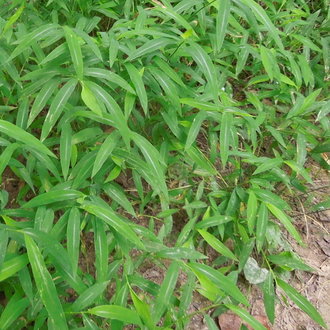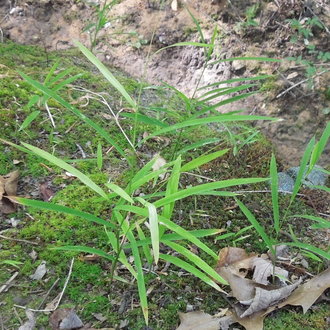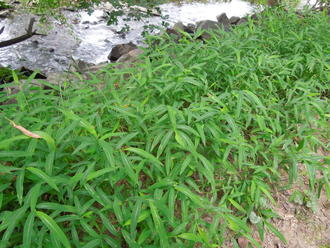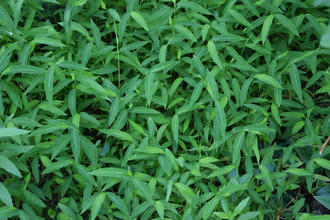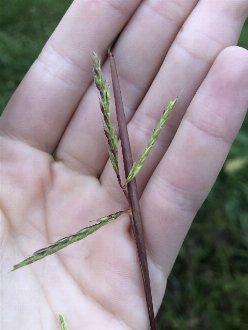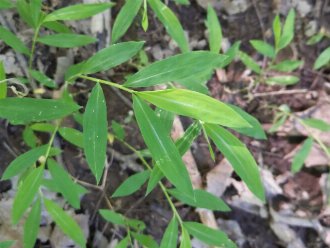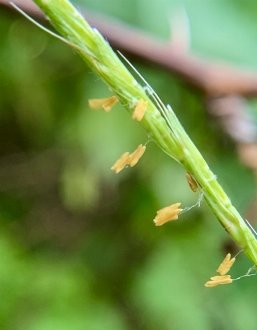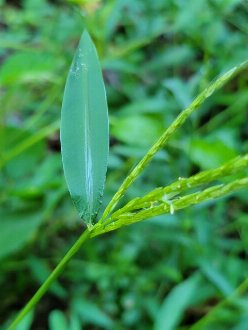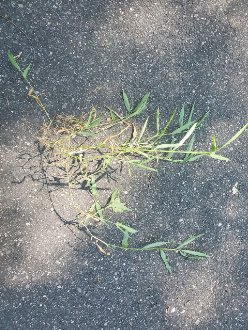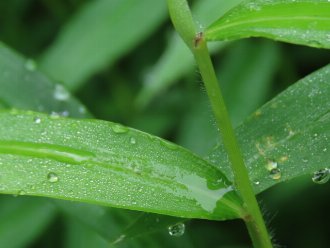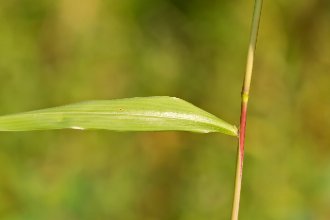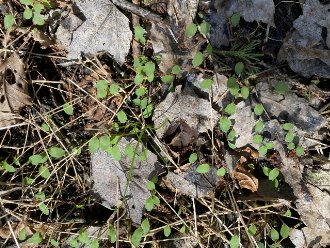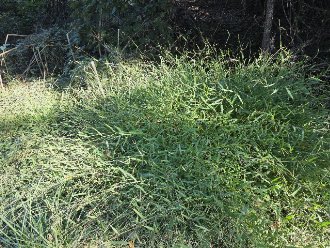Japanese Stiltgrass (Microstegium vimineum (Trin.) A. Camus)
Also known as Nepalese browntop, packing grass, Japanese stilt grass.
↑Summary
A shallow-rooted annual grass native to south and east Asia, and invasive in the eastern US.
↑Range - Expand
| Legend | Color |
| Introduced or Not Present | |
| Introduced |
This tentative map is based on our own research. It may have limited data on Canada and/or Mexico, and there is some subjectivity in our assignment of plants as introduced vs. expanded. Read more in this blog post.
Although this plant occurs somewhere in each of these regions, it may only occur in a small part of some or all of them.
↑Similar Plants
↑Habitat
Stiltgrass is found in a wide variety of moist to mesic, partly-sunny to lightly-shaded habitats, favoring disturbed habitats. It is most invasive in a zone from about northern Mississippi, Alabama, and Georgia northeast to southern Indiana, Ohio, and Pennsylvania, to Connecicut and along the East Coast south to North Carolina. Natural habitats include bottomland forests, forest edges and openings, thinly wooded ravines, and forests that have burned recently. Frequently found in anthropogenic habitats, including small, fragmented woodlands, suburban gardens, parks, lawns, abandoned mines, tree plantations, and forests thinned by logging.
It is most dominant in moist to mesic conditions, but it can sometimes range into slightly dry sites, where it grows less vigorously. It can also sometimes range onto wet sites with waterlogged soils.
It can occasionally survive in full sun with sufficient moisture, but it usually is found on sites with some shade. It is largely indifferent to the type of tree cover in the canopy. It can survive with as little as 5% sunlight but grows best with at least a few hours of direct sun.
It can occur on soil textures including loam, clay-loam, silt-loam, and sandy-loam, and it can tolerate only moderate soil acidity (pH >= 4.6) and is often most abundant on soils closer to neutral pH. It may prefer soil with high phosphorus and potassium content, but studies of other nutrient preferences have been conflicting.
Stiltgrass relies both on ground-level disturbance to germinate and establish, and slightly larger-scale disturbances that open up the forest canopy creating its preferred lighting condition. It establishes poorly in deep, coarse leaf litter and thus is usually limited to areas where there is either less litter accumulation, the litter breaks down quickly, or the litter is pushed aside. It can persist in late successional stages of forests but becomes less common there.
Heavy deer browsing favor this species, and stiltgrass often forms large monocultures in areas with deer overpopulation. Besides introducing stiltgrass, humans have hugely increased its habitat by fragmenting forests with roads and paths, clearing native vegetation that competes with it, and contributing to deer overpopulation. Introduction of invasive earthworms has also favored this species by causing leaf litter to break down faster, thus exposing the soil and giving this species space in which to establish.
↑Life Cycle
This species is an annual whose seeds sprout relatively late in the spring. Most growth is mainly during the warm months. It uses the water-conserving C4 metabolism, which, combined with the shady habitats in which it is found, allows it to have an exceptionally high ratio of leaf surface area to root volume.
Branches frequently and roots at nodes, often forming mats or colonies from a single plant. This growth habit is advantageous on wet and poorly-drained sites, as it can allow it to root in a better-aerated portion of soil, and it also can aid this plant in situations where soil fertility is patchy on a small scale. Stems will push up through competing vegetation, growing significantly taller in the presence of competition. In the absence of such vegetation, it often sprawls horizontally.
Plants starts blooming in late summer to early fall. Seed matures shortly thereafter, after which plants die.
The seed can persist in the seed bank for 3-5 years; however, a large portion of the seed will germinate in the first year if there are favorable conditions for germination.
↑Faunal Associations
Deer and livestock find this grass low in palatability, possibly because its foliage has a high silica content. Deer may browse on it slightly but it is usually so abundant that the presence of deer highly favors it.
Stiltgrass is eaten by a number of generalist insects, including leafhoppers, seedbugs (Lygaeidae), grasshoppers, and crickets. The presence of stiltgrass tends to increase the population of these insects, which in turn are eaten by damsel bugs (Nabidae).
The white-footed mouse (Peromyscus leucopus) tends to use large colonies of this plant as cover, and tends to increase in numbers in infested areas.
↑Control
Stiltgrass is a species where control is heavily knowledge-limited. Ineffective control efforts can waste resources and sometimes even cause more harm than good. Effective control of this plant requires a holistic approach that involves careful timing, follow-up, and may involve addressing systemic factors such as deer overpopulation, source populations, corridors and mechanisms of spread, and reestablishing competing vegetation. However, effective control of this plant can often be a "low hanging fruit" of ecological restoration, yielding large results with only modest effort, creating plant communities resistant to recolonization by stiltgrass, and addressing other issues such as reducing soil erosion and improving water quality in riparian areas.
Small to moderate infestations are easy to manually control. As stiltgrass has shallow roots and is easily uprooted, large amounts of it can be pulled by hand without any tools, without causing much disturbance to soil or damage to competing vegetation. Timing of control is critically important; plants pulled before seed matures can be left to die in place, thus minimizing effort. Control attempts carried out too late, after the seed has matured and already begun to be distributed, may achieve little or no results.
Typically, multiple years of control are necessary to remove this species from a site. However, most of the effort needed is concentrated in the first year, as numbers are typically greatly reduced after a single year of control, and in third or later years there are usually only a few isolated plants.
Large, widespread infestations are best controlled by addressing systemic factors, including addressing deer overpopulation, reintroducing competing vegetation, particularly perennial herbaceous plants, and changing management practices such that management is no longer favoring stiltgrass establishment and spread.
Large infestations can have their seed production reduced by using a string trimmer a key window shortly before the plant blooms, typically in July in much of this plant's range. Mowing is less effective than using a string trimmer, as some of the lower leaf blades tend to survive mowing. Mowing or trimming is best delayed until June at the earliest, as control timed too early will result in new seedlings establishing and growing to maturity.
Several herbicides can be effective against stiltgrass. Glufosinate, which is less transported through plant tissue than other herbicide, and thus affects annuals more than perennials; it can be effective when stiltgrass is competing primarily against perennial vegetation. Quizalofop is a selective herbicide that only affects grasses; it also is more effective against stiltgrass than most other grasses. It is particularly effective when stiltgrass is mostly competing against broadleaf vegetation, but it can be useed even where it is competing against native grasses, if the concentration is carefully chosen. Glyphosate is non-selective and easily transported into plant tissues, and can kill most vegetation, but stiltgrass is still more susceptible to it than most other plants, so a low concentration of glyphosate very carefully applied can sometimes kill stiltgrass with minimal harm to competing vegetation.
Pre-emergent herbicides can be effective at controlling stiltgrass by preventing seed germination, and will do so without harming established vegetation. However, they also hinder other seed germination. Pre-emergent is thus most effective when stiltgrass is competing against desireable perennial vegetation, and on sites where the seed bank and/or seed rain contains few other native species and/or contains many other invasives. It is unsuitable however, on sites where you are actively seeding in other native species, or where stiltgrass is competing primarily against native annuals, or where seed rain and germination of native vegetation is high. Pre-emergents effective against stiltgrass include prodiamine or pendimethalin. Timing of pre-emergents however is difficult because it must be applied within a 2-3 week window, but stiltgrass germination timing is a function of temperature and may thus occur at different times in different years.
↑Uses
Stiltgrass was historically used as a packing material for porcelain imported from China, and was probably introduced to North America through this means.
↑Related Plants
There are numerous other plants in the Microstegium genus, but none of them around found in North America; the genus is primarily found in Africa, Asia, and Pacific Islands. More broadly, this genus belongs to the Andropogoneae, or "sorghum tribe" of grasses, but its placement within this tribe is uncertain.
There is recent evidence, which we found compelling, that the Microstegium genus itself, as typically treated, is not monophyletic, and includes not-very-closely related species that may not even belong to the same subtribes of the Andropogoneae tribe. A relatively recent DNA analysis (specifically ITS) has placed this species as belonging to the Saccharinae subtribe, and more specifically, closest-related to the Polytrias and Eulalia genera. Of these, only Java grass (Polytrias indica) occurs in North America, where it is introduced.
Within this broader subtribe, there are both numerous native and introduced species.
↑Notes
The presence of stiltgrass in forests, particularly in riparian areas and floodplain forests, not only reduces native plant biodiversity, but creates a series of environmental problems. The short lifecycle and shallow root system of stiltgrass are poor at holding soil, and stiltgrass often shades out other species that are perennial and have deeper and more robust root systems. As such, it can create a serious erosion problem. The fact that it primarily occurs along riparian areas, where flooding is frequent and soil can be washed into waterways, increases the magnitude of this problem: not only can stiltgrass lead to soil loss, but also to a decline in water quality in areas downstream.
Stiltgrass infestation rarely exists in isolation, but rather, is part of a system of problems that involve degradation of multiple aspects of an ecosystem. It is often associated with and in part caused or worsened by deer overpopulation. It is also facilitated by invasive earthworms, which cause leaf litter to break down more rapidly. Furthermore, it is favored by habitat fragmentation by roads and paths. And it is more likely to occur in areas where there are fewer native plants providing ground-level competition. All of these factors cause problems for ecosystems beyond stiltgrass itself.
↑Links & External Resources
• Nepalese Browntop | Fire Effects Information System (FEIS) (About This Site)
• Microstegium vimineum (Japanese Stiltgrass) | Illinois Wildflowers (About This Site)
• Microstegium vimineum (Japanese Stiltgrass) | USDA PLANTS Database (About This Site)
• Microstegium vimineum | Go Botany (About This Site)
• Microstegium vimineum | Biota of North America Project (BONAP) (About This Site)
• Microstegium vimineum | NatureServe Explorer (About This Site)
• Microstegium vimineum | Flora of North America (About This Site)
• Microstegium vimineum | Missouri Plants (About This Site)
• Japanese Stiltgrass | Maryland Biodiversity Project (About This Site)
• Microstegium vimineum (Trin.) A. Camus (Japanese Stiltgrass, Nepalese Brown-top, Japanese Grass) | Digital Atlas of the Virginia Flora (About This Site)



